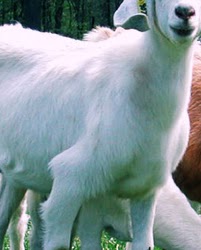When looking at the leg as a whole, the Kinder goat breed standard calls for legs that are "moderately heavy boned but not coarse. Strong, sturdy, straight, wide apart, providing ample height for udder clearance. Pasterns medium length. Strong and springy with proper slope. Rear legs when viewed from behind set wide apart and straight; when viewed from the side, well angulated from thurl to hock. Hock cleanly molded, straight from hock to pastern."
When looking for the ideal, it is sometimes easier to see and avoid obvious faults than to find perfection, so I'll proceed by listing and describing the most common legs faults:
Weak Pasterns
The pastern is the length of leg from the hoof to the first knuckle, or basically up to their dewclaws. Ideally, this part of their leg should be short and almost vertical. The longer and more sloped the pastern is, the more risk there is of it breaking down as a goat ages, or as the weight of pregnancy and milk take their toll.
Here are a young doeling and adult doe with good pasterns:
I would consider this doe one whose pasterns I need to watch - being only 2 1/2 years old, I would like to see her pasterns a bit more straight. I would only breed her to bucks with very strong pasterns:
The following two photos are of poor front and rear pasterns. These pasterns are long and weak, allowing the leg to fall much lower and further behind the hoof than ideal:
Sickle and/or Cow Hocked:
Not only do turned in knees cause weakness in the rear end of the goat, but in milking does, they often rub on the doe's udder, causing damage and sores as well as discomfort.
Rear legs too much in front of or behind the vertical:
When viewed from the side standing naturally, you should be able to draw a straight line perpendicular to the ground from the pin bone down through the hock to the ankle. Take care that the goat is not post-legged though.
Post-legged:
Viewed from the side, the rear legs of a post-legged will look almost straight, with no bend at the knee or dip above the hock. Without adequate angle to their hocks, these goats loose the shock absorption that correct angles allow. It can also cause the hips to be higher than the goat's front end, putting all of her weight on her front end.
This buck is a bit post-legged - even standing with his rear legs very far under him, you can see the lack of angle in his knee:
Wing shoulders:
Loose attachment between the ribcage and the humerus. In a goat with good attachments, the elbow is held tightly to their side, while one with loose attachments will have space between their body and elbow. Wing shoulders will decrease the strength in the front end of the goat, causing fatigue and discomfort. The way this doe is standing exaggerates how much her elbow protrudes, but makes for a good example of winged shoulders:
These problems can vary a great deal in severity, from almost unnoticeable to so extreme that they affect the movement of the goat. When choosing goats and breeding pairs, taking your goats' leg strengths and weakness into account will allow you to breed for stronger, sturdier kids and goats that "stand" the test of time!









Good article. I'm thinking proper hoof trimming will help with feet and pasterns.
ReplyDeletenice post! thanks for sharing
ReplyDelete